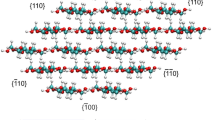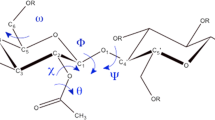Abstract
Cellulose is one of the most versatile substances in the world. Its immense variety of applications was in recent years complemented by nanotechnological applications such as cellulose nanoparticle dressed surfaces for filtration purposes or cellulose matrices for microelectronics. The fabrication of such complex materials asks for thorough understanding of the surface structure and its interactions with adsorbates. In this study we investigate several surface model systems of nanotechnological interest, which are obtained by reorganization of the cellulose-vacuum or cellulose-water interfaces of slabs of crystalline cellulose. To do this, we equilibrated first bulk supercells of different cellulose allomorphs, which were constructed from crystallographic data, and then optimized the interface structures. From the bulk and surface systems we calculated structural properties such as unit cell parameters, dihedral conformation distributions, density profiles and hydrogen bonding. The results suggest that no overall geometrical restructuring occurs at the interface. However, the hydrogen bond network is strongly reconstructed, as is inferred from the dihedral conformations and hydrogen bond occurrences, although only within the first few layers. This holds for low index close packed structures as well as for high index loosely packed surfaces. Replacing the vacuum by ambient pressure water molecules we find less rearrangements of the cellulose surface, because the water allows formation of hydrogen bonds similar to those in the bulk phase. The water near the cellulose surface shows, however, strong structural changes. We observe reduced mobility of the water molecules, which corresponds to a cooling of water by about 30°, in a slab that is about 10 Å thick. Although structuring and adsorption is observed on all surfaces, no actual penetration of water into the cellulose structure could be observed. This suggests that pure water is not sufficient to produce cellulose swelling at mesoscopic timescales. This work lays the basis for current quantum chemical investigations on specific interaction terms within cellulose.











Similar content being viewed by others
References
Aulin C, Ahola S, Josefsson P, Nishino T, Hirose Y, Osterberg M, Wagberg L (2009) Nanoscale cellulose films with different crystallinities and mesostructures–their surface properties and interaction with water. Langmuir 25(13):7675–7685
Baker AA, Helbert W, Sugiyama J, Miles MJ (2000) New Insight into cellulose structure by atomic force microscopy shows the Iα crystal phase at near-atomic resolution. Biophys J 79:1139–1145
Bergenstrahle M, Berglund LA, Mazeau K (2007) Thermal response in crystalline Ibeta cellulose: a molecular dynamics study. J Phys Chem B 111(30):9138–9145
Bergenstrahle M, Mazeau K, Berglund L (2008) Molecular modeling of interfaces between cellulose crystals and surrounding molecules: effects of caprolactone surface grafting. Eur Polym J 44(11):3662–3669
Biermann O, Hädicke E, Koltzenburg S, Müller-Plathe F (2001) Hydrophilicity and lipophilicity of cellulose crystal surfaces. Angew Chem Int Ed 40(20):3822–3825
Case DA, Cheatham TE, Darden T, Gohlke H, Luo R, Merz KM, Onufriev A, Simmerling C, Wang B, Woods RJ (2005) The Amber biomolecular simulation programs. J Comput Chem 26(16):1668–1688
Chen P, Nishiyama Y, Mazeau K (2012) Torsional entropy at the origin of the reversible temperature-induced phase transition of cellulose. Macromol 45(1):362–368
Degarmo EP, Black JT, Kohser RA (2003) Materials and processes in manufacturing, 9th edn. Wiley, New Jersey
Eichhorn SJ, Young RJ, Davies GR (2005) Modeling crystal and molecular deformation in regenerated cellulose fibers. Biomacromol 6(1):507–513
Eichhorn SJ, Dufresne A, Aranguren M, Marcovich NE, Capadona JR, Rowan SJ, Weder C, Thielemans W, Roman M, Renneckar S, Gindl W, Veigel S, Keckes J, Yano H, Abe K, Nogi M, Nakagaito AN, Mangalam A, Simonsen J, Benight AS, Bismarck A, Berglund LA, Peijs T (2010) Review: current international research into cellulose nanofibres and nanocomposites. J Mater Sci 45(1):1–33
Gardner KH, Blackwell J (1974) The hydrogen bonding in native cellulose. Biochim Biophys Acta 343(1):232–237
Gardner KH, Blackwell J (1974) The structure of native cellulose. Biopolymers 13(10):1975–2001
Hardy B, Sarko A (1996) Molecular dynamics simulations and diffraction-based analysis of the native cellulose fibre: structural modelling of the I-α and I-β phases and their interconversion. Polymer 37(10):1833–1839
Harris KR, Woolf LA (1980) Pressure and temperature dependence of the self diffusion coefficient of water and oxygen-18 water. J Chem Soc Faraday Trans 1 F 76:377–385
Heiner AP, Teleman O (1997) Interface between monoclinic crystalline cellulose and water: breakdown of the odd/even duplicity. Langmuir 13(3):511–518
Heiner AP, Sugiyama J, Teleman O (1995) Crystalline cellulose I [alpha] and I [beta] studied by molecular dynamics simulation. Carbohydr Res 273(2):207–223
Heiner AP, Kuutti L, Teleman O (1998) Comparison of the interface between water and four surfaces of native crystalline cellulose by molecular dynamics simulations. Carbohydr Res 306:205–220
Holz M, Heil S, Sacco A (2000) Temperature-dependent self-diffusion coefficients of water and six selected molecular liquids for calibration in accurate 1H NMR PFG measurements. Phys Chem Chem Phys 2:4740–4742
Hornig S, Heinze T (2008) Efficient approach to design stable water-dispersible nanoparticles of hydrophobic cellulose esters. Biomacromol 9(5):1487–1492
Humphrey W, Dalke A, Schulten K (1996) VMD–visual molecular dynamics. J Molec Graph 14:33–38
Jorgensen WL, Chandrasekhar J, Madura JD, Impey RW, Klein ML (1983) Comparison of simple potential functions for simulating liquid water. J Chem Phys 79(2):926–935
Kirschner KN, Yongye AB, Tschampel SM, Gonzalez-Outeirino J, Daniels CR, Foley BL, Woods RJ (2008) GLYCAM06: a generalizable biomolecular force field. Carbohydrates. J Comput Chem 29(4):622–655
Kolpak FJ, Blackwell J (1976) Determination of the structure of cellulose II. Macromol 9(2):273–278
Kontturi E, Suchy M, Penttilä P, Jean B, Pirkkalainen K, Torkkeli M, Serimaa R (2011) Amorphous characteristics of an ultrathin cellulose film. Biomacromol 12(2):770–777
Kroon-Batenburg LMJ, Kroon J (1997) The crystal and molecular structures of cellulose I and II. Glycoconj J 14(5):677–690
Kroon-Batenburg LMJ, Bouma B, Kroon J (1996) Stability of Cellulose Structures Studied by MD Simulations. Could mercerized cellulose II Be parallel? Macromol 29(17):5695–5699
Langan P, Nishiyama Y, Chanzy H (1999) A revised structure and hydrogen-bonding system in cellulose II from a neutron fiber diffraction analysis. J Am Chem Soc 121(43):9940–9946
Martinez L, Andrade R, Birgin EG, Martinez JM (2009) PACKMOL: a package for building initial configurations for molecular dynamics simulations. J Comput Chem 30:2157–2164
Matthews JF, Skopec CE, Mason PE, Zuccato P, Torget RW, Sugiyama J, Himmel ME, Brady JW (2006) Computer simulation studies of microcrystalline cellulose I beta. Carbohydr Res 341:138–152
Mazeau K (2011) On the external morphology of native cellulose microfibrils. Carbohydr Polym 84(4):524–532
Mazeau K, Heux L (2003) Molecular dynamics simulations of bulk native crystalline and amorphous structures of cellulose. J Phys Chem B 107(10):2394–2403
Mazeau K, Rivet A (2008) Wetting the (110) and (100) surfaces of Ibeta cellulose studied by molecular dynamics. Biomacromol 9(4):1352–4
Mazeau K, Vergelati C (2002) Atomistic modeling of the adsorption of benzophenone onto cellulosic surfaces. Langmuir 18(5):1919–1927
Newman RH, Davidson TC (2004) Molecular conformations at the cellulose–water interface. Cellulose 11:23–32
Nishiyama Y, Langan P, Chanzy H (2002) Crystal structure and hydrogen-bonding system in cellulose Iβ from synchrotron X-ray and neutron fiber diffraction. J Am Chem Soc 124(31):9074–9082
Nishiyama Y, Sugiyama J, Chanzy H, Langan P (2003) Crystal structure and hydrogen bonding system in cellulose I(alpha) from synchrotron X-ray and neutron fiber diffraction. J Am Chem Soc 125(47):14,300–14,306
O’Sullivan A (1997) Cellulose: the structure slowly unravels. Cellulose 4:173–207
Perez S, Kouwijzer M, Mazeau K, Balling Engelsen S (1996) Modeling polysaccharides: present status and challenges. J Mol Graph 14(6):307–321
Radloff D, Boeffel C, Spiess HW (1996) Cellulose and cellulose/Poly(vinyl alcohol) Blends. 2. Water organization revealed by solid-state NMR spectroscopy. Macromol 29(5):1528–1534
Sherwood P, de Vries A, Guest M, Schreckenbach G, Catlow C, French S, Sokol A, Bromley S, Thiel W, Turner A, Billeter S, Terstegen F, Thiel S, Kendrick S, Kendrick J, Rogers S, Casci J, Watson M, King F, Karlsen E, Sjovoll M, Fahmi A, Schäfer A, C L (2003) QUASI: a general purpose implementation of the QM/MM approach and its application to problems in catalysis. J Mol Struct: THEOCHEM 632(1-3):1–28
Smith W, Todorov IT, Leslie M (2005) The DL_POLY molecular dynamics package. Z Kristallogr 220(5–6):563–566
Taylor RE, French AD, Gamble GR, Himmelsbach DS, Stipanovic RD, Thibodeaux DP, Wakelyn PJ, Dybowski C (2008) 1H and 13C solid state NMR of Gossypium barbadense (Pima) cotton. J Mol Struct 878:177–184
Vega C, Abascal J, Conde M, Aragones J (2009) What ice can teach us about water interactions: a critical comparison of the performance of different water models. Faraday Discuss 141:251–276
Vietor RJ, Mazeau K, Lakin M, Perez S (2000) A priori crystal structure prediction of native celluloses. Biopolymers 54(5):342–354
Wada M, Chanzy H, Nishiyama Y, Langan P (2004) Cellulose III crystal structure and hydrogen bonding by synchrotron X-ray and neutron fiber diffraction. Macromol 37(23):8548–8555
Wada M, Heux L, Sugiyama J (2004) Polymorphism of cellulose I family: reinvestigation of cellulose IVI. Biomacromol 5:1385–1391
Yamamoto H, Horii F, Odani H (1989) Structural-Changes of native cellulose crystals induced by annealing in aqueous alkaline and acidic solutions at high-temperatures. Macromol 22(10):4130–4132
Youngs TGA (2010) Aten: an application for the creation, editing, and visualization of coordinates for glasses, liquids, crystals, and molecules. J Comput Chem 31(3):639–648
Yui T, Hayashi S (2007) Molecular dynamics simulations of solvated crystal models of cellulose I-alpha and IIII. Biomacromol 8:817–824
Yui T, Nishimura S, Akiba S, Hayashi S (2006) Swelling behavior of the cellulose I beta crystal models by molecular dynamics. Carbohydr Res 341:2521–2530
Zhang Q, Bulone V, Ågren H, Tu Y (2011) A molecular dynamics study of the thermal response of crystalline cellulose Ibeta. Cellulose 18(2):207–221
Acknowledgments
The authors like to acknowledge financial support by the European Union Framework Program 7 Project SURFUNCELL, Grant agreement No.: 214653, and the helpful comments of an unknown reviewer.
Author information
Authors and Affiliations
Corresponding author
Rights and permissions
About this article
Cite this article
Maurer, R.J., Sax, A.F. & Ribitsch, V. Molecular simulation of surface reorganization and wetting in crystalline cellulose I and II. Cellulose 20, 25–42 (2013). https://doi.org/10.1007/s10570-012-9835-9
Received:
Accepted:
Published:
Issue Date:
DOI: https://doi.org/10.1007/s10570-012-9835-9




